
About Andrew Cusack
 Writer, web designer, etc.; born in New York; educated in Argentina, Scotland, and South Africa; now based in London.
Writer, web designer, etc.; born in New York; educated in Argentina, Scotland, and South Africa; now based in London. read more
News
Blogs
Reviews & Periodicals
Arts & Design
World
France
Mitteleuropa
Knickerbockers
Argentina
The Levant
Africa
Cape of Good Hope
Netherlands
Scandinavia
Québec
India
Muscovy
Germany
Academica
Passenger Ship Chapels
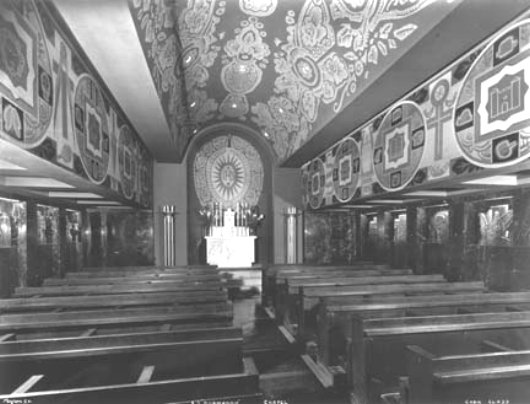
Above & below: the SS Normandie. The Normandie was seized by the U.S. government and renamed the USS Lafayette but burned in New York harbor before she could be put to good use in the war effort. The bronze doors to the chapel were salvaged and now grace the Church of Our Lady of Lebanon in Brooklyn.
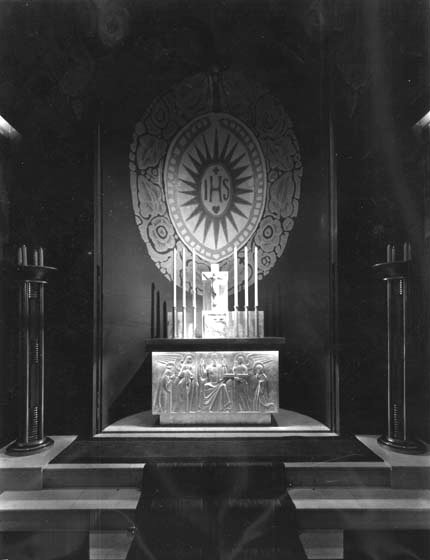
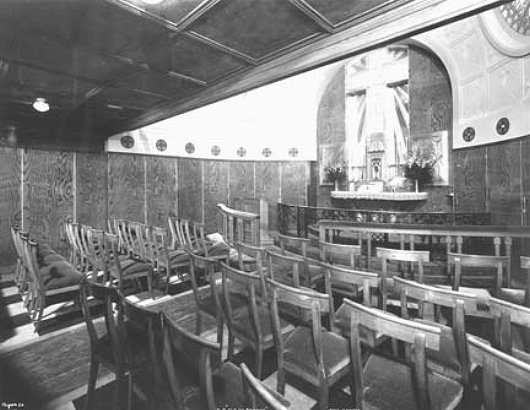
Above & below: the SS Ile de France. The Ile de France was the first liner built entirely in the art-deco style. She was scrapped at Osaka, Japan in 1959, but the ninth floor restaurant at Eaton’s in Montréal was designed in imitation of the first-class dining room of the Ile de France at the request of the department store owner’s wife.
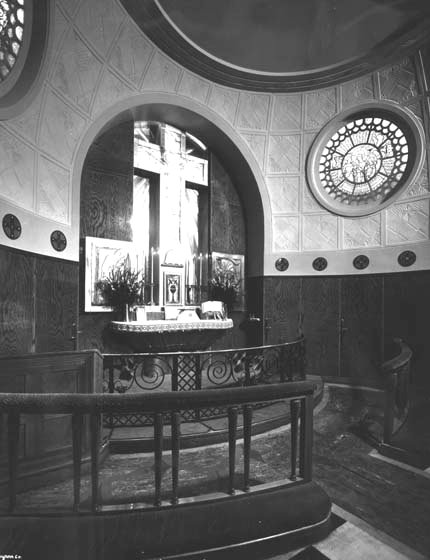
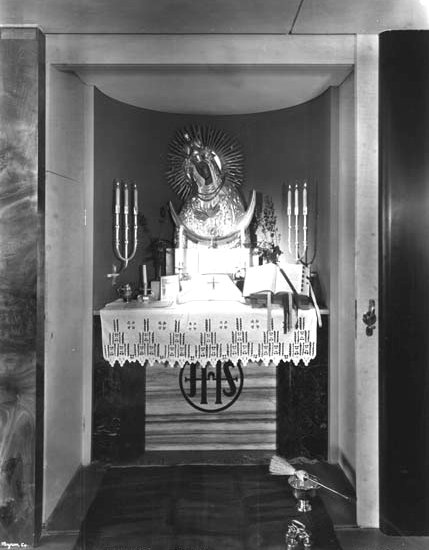
Above: the MS Piłsudski. The Piłsudski was launched in 1935, but sank in November 1939 during her first journey after the start of the Second World War. The Piłsudski is now the biggest shipwreck on the Yorkshire coastline. Unlike those on the Normandie and the Ile de France, the smaller Polish vessel merely hid an altar behind a moving panel rather than devoting space to a dedicated chapel — this was a more common practice on smaller-to-mid-sized ocean liners as well as on liners from Protestant countries.
Search
Instagram: @andcusack
Click here for my Instagram photos.Most Recent Posts
- Silver Jubilee November 21, 2024
- Articles of Note: 11 November 2024 November 11, 2024
- Why do you read? November 5, 2024
- India November 4, 2024
- The Lithe Efficiency of the Old Constitution November 4, 2024
Most Recent Comments
Book Wishlist
Monthly Archives
Categories



Your post reminds me of a problem (small in the scale of this world, but metaphysically gigantic) that cruise line are having now days credentialing priests who cruise on reduced (or sometimes free) fares while providing Catholic chaplaincy shipboard. Some of these men, it turns out, are scam artists. Others are not in good standing. Cruise lines were warned some years ago (I think by the chancery in New York) to carefully go over the bona fides of priests who seek to perform these services.
The post also reminded me of a peculiarity in the old Code of Canon Law which stated that only Cardinals had a general permission to say mass at sea. (it was, in fact, one of their general privileges.) All other ecclesiastics had to seek permission from the Holy See. The reasoning for this rule was a bit muddled by the mists of time. Some canonists supposed that this had to do with the danger of profanation that came with saying mass on the open decks of sailing ships, and in granting a dispensation had to be convinced that the celebrant and the site of celebration would minimize this risk. Others suppose that it was a fundamental question of jurisdiction. That is, no priest, by right of incarnation, has the faculties to say mass on the open sea, which falls outside of the ordinary jurisdiction of dioceses, and that Cardinals, by right of possessing a share of the universal jurisdiction of the Pope, had the right to say mass at sea, just as they had the right to say mass in any diocese.
Wow! I can’t believe how elabourate these chapels are! Were they unusually so?
You write that the Pilsudski “sank”. Do you not perhaps mean “was sunk”?
I sadly must agree with the first post.
Several years ago while on a cruise of the Mediterranean, the Cruise Director announced services on board the ship. To my horror, it was held in the Discotheque and the bar remained open during services. The Priest conducting services left much to be desired; and looking back I wonder if he was a legitimate priest, not some scam artist getting a free cruise.
On the other hand, it has been my experience that on cruise ships under Greek flag, there is a dedicated chapel on board the ship.
I really have to thank you for this wonderful site. Everytime I visit it, I find some amazing new pictures or texts.
A very warm “Thank you” from Germany and, under all circumstances, keep up this most enjoyable corner of the web.
should be “by right of incardnation” in mine. No one has the right to say Mass at all by “right of incarnation.”
The Italian liners usually had chapels, and I think the France of 1962 did as well. Must see if we can find photos. Of course, as in everything about it, the Normandie’s chapel was the most splendid.
Thank you for these fascinating pictures. I have had a niggling curiosity about this subject of shipboard chapels for over 50 years, since I first read “The Cardinal”, with its reference to the “exquisite chapel” on board a (fictional) Italian liner between the wars. I look forward eagerly to seeing if your readers will come up with any more such images.
I am an ocean liner buff. In the late 50’s and early 60’s I visited many liners before they sailed from NYC. I do remember the chapel on the ‘Liberte’…French Line. My mom and I peaked in and knelt for a prayer…moments later an officer asked us yo leave saying the chapel was usually locked while in port. I was a fair size at the top of a nice stairway, and quite nice inside. Years later I sailed on the ‘France’ and mass was said in the theater. There was also a small chapel. I have an Italian Lines folder from the 50′ that shows all their ships chapels.
Thank you for your passion on this subject. I would love to know the author of the book referenced by Sacerdos and would love to see a copy of the Italia Lines chapel folder by Ken. I just bought the chapel from the Augustus !
A dedicated prayer space seems to have fallen out of favor… on today’s cruise ships if there is a chapel it is for revenue-generating weddings. I don’t know if you are even allowed in at other times.
I have always been curious about the inclusion of a dedicated chapel aboard the 1970s built Royal Viking Star. I am not sure if this was intended for weddings or religious services or both, but it was interesting to me that such a small ship had a comparatively large dedicated space, and her two near-sisters did not.
I was aboard in 2008 and it had since been replaced by cabins, but the original blank T-shaped space is still on the deck plan.